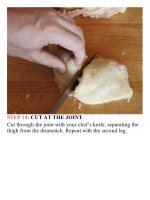The food lab better home cooking through science ( PDFDrive ) 101
Bạn đang xem bản rút gọn của tài liệu. Xem và tải ngay bản đầy đủ của tài liệu tại đây (177.61 KB, 2 trang )
bathing,andspreadingtheirwings.Free-RangeandFreeRoaming chickens generally also have access to outdoor
areas,butthelabelinglawshavenorequirementsasfaras
the size or quality of the area goes, nor for how long the
chickens must be allowed out. Fact of the matter is, most
of these chickens never set foot outside the barn. These
labels are not audited—you’re going on the word of the
produceralone.
•CertifiedOrganiceggscomefromchickenskeptinopen
barns or warehouses with an unspecified degree of
outdoor access (again, for all intents and purposes,
probably none). They must be fed an organic, allvegetariandietfreeofanimalby-products,antibiotics,and
pesticides, and farms are checked for compliance by the
USDA.
•CertifiedHumaneeggshavebeenverifiedbythird-party
auditors, and this label requires stricter controls on
stockingdensities,givingthechickensmorespaceandthe
ability to engage in natural behaviors like nesting and
perching. Producers are not allowed to engage in forced
molting,thepracticeofinducinghensintoalayingcycle
by starving them (this practice is allowed for all other
typesofeggs).
• Omega-3–Enriched eggs come from chickens that have
been fed supplements made from flaxseed or fish oil to
increase the levels of omega-3 fatty acid—an essential
fatty acid touted with several health benefits—in their
yolks. While some people claim eggs high in omega-3s
have a “fishy” aroma, in blind tastings, I’ve found no
significantdifferencesinthewaytheseeggstaste.
If animal welfare is a concern, you are making a good
step in the right direction by purchasing only Certified
Organic or Certified Humane eggs. If you’ve got a local
farmers’ market where you can actually talk to the farmer
producing the eggs you’re purchasing, you’re making an
evenbetterdecision.Ofcourse,theverybestthingyoucan
doistobuildyourowncoop(or,betteryet,convinceyour
neighbor to do so) and keep a couple chickens. It won’t
save you much money in the long run, unless you keep a
large flock and eat alot of eggs, but you’ll have the
freshest-possible eggs and probably make plenty of friends
intheprocess.
Q:That’sallwellandgoodforthechickens,butdo
CertifiedOrganicorlocaleggstastebetter,liketheguys
atthefarmers’marketwouldlikeyoutothink?
That’s a good question, and one that I’ve wondered about
often. It seems natural that a happier, healthier chicken
roamingaroundabackyardpoking,scratching,eatingbugs
andworms,clucking,anddoingallthecharmingandfunny
things chickens do should produce tastier eggs, right? I
mean, Iknow that some of the best-tasting eggs I’ve ever
eaten have come fresh out of the coops or backyards of
friends who keep their own flocks.The yolks were richer,
thewhitestighterandmoreflavorful,anditwasjustanallaround better experience. Or was it? What if all their
greatnesswassimplyinmyhead?
To test this, I organized a blind tasting in which I had
tasters taste regular supermarket eggs, plain organic eggs,
organiceggswithvaryinglevelsofomega-3,andeggsfresh









